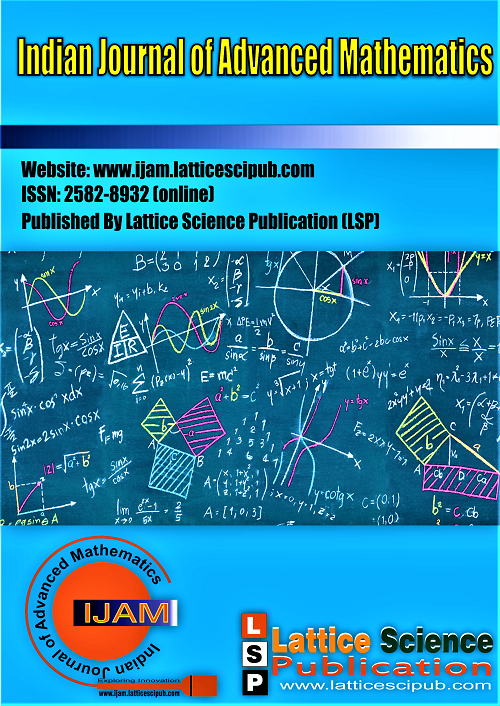Existence and Uniqueness of Weak Solutions to the Fractional Navier-Stokes Equations in Turbulent Flows: A Study of Boundedness and Stability
Main Article Content
Abstract
This study employs fractional analysis to investigate the existence and uniqueness of weak solutions to the fractional NavierStokes equations in three-dimensional turbulent flows, thereby addressing the complexity inherent in turbulent regimes. Turbulence presents significant challenges in fluid dynamics, characterised by chaotic and erratic motion that confounds conventional modelling techniques. By reformulating the NavierStokes equations using fractional derivatives, we capture non-local effects and memory phenomena, thereby enhancing the mathematical representation of fluid behaviour. First, we transform the Navier-Stokes equations to demonstrate the utility of fractional analysis. The second thing we do is show that there are weak answers in some situations. This means that we can use our models with starting data that isn't stable. This is the third thing we do. We show that these answers are unique. This proves that our models are right. Ultimately, we demonstrate that weak solutions remain bounded over time under specific conditions regarding the initial data and external forces. When the Reynolds number approaches a critical level, we investigate its stability. This helps us understand how smooth flow can become rough flow. The findings of this research not only advance the theoretical understanding of weak solutions to the fractional Navier-Stokes equations but also have practical implications for modeling complex fluid systems. By linking fractional derivatives with turbulent flows, this work contributes to the broader field of fluid dynamics, paving the way for future investigations in applied mathematics and engineering. Ultimately, this exploration enhances our understanding of turbulence and its mathematical foundations, emphasising the importance of fractional calculus in accurately modelling fluid dynamics.
Downloads
Article Details

This work is licensed under a Creative Commons Attribution-NonCommercial-NoDerivatives 4.0 International License.
How to Cite
References
Uddin, A., Juyal, P., Shah, R., Kailasavalli, S., Bharani, J.S.S.L., & K, H. (2025). A comprehensive review of fractional calculus in modelling real-world phenomena. Communications on Applied Nonlinear Analysis, 32(9s), 1-12. DOI: https://doi.org/10.52783/cana.v32.4182.
Burtea, C., & Szlenk, M. (2025). Weak solutions to the Navier–Stokes equations for steady compressible non-Newtonian fluids. Nonlinear Analysis, 255, 113774. DOI: https://doi.org/10.1016/j.na.2025.113774.
Barbero, G., Evangelista, L. R., Zola, R. S., Lenzi, E. K., & Scarfone, A. M. (2024). A brief review of fractional calculus as a tool for applications in physics: Adsorption phenomena and electrical impedance in complex fluids. Fractal and Fractional, 8(7), 369.
DOI: https://doi.org/10.3390/fractalfract8070369.
Aserkar, A., Rv, S., Nalawade, R., Reddy, B., Balamurugan, M., & Mallesh, M. (2025). Mathematical modelling of turbulent flows using advanced computational fluid dynamics techniques. Metallurgical and Materials Engineering, 31, 210-219.
DOI: https://doi.org/10.63278/1358.
Soltanov, K. (2024). Remarks on the uniqueness of weak solutions of the incompressible Navier–Stokes equations. Russian Journal of Mathematical Physics, 31(4), 544-561. DOI: https://doi.org/10.1134/S1061920824030154.
Matychyn, I., & Onyshchenko, V. (2024). Fractional differential equation on the whole axis involving the Liouville derivative. Fractional Calculus and Applied Analysis, 27, 2275–2283. DOI: https://doi.org/10.1007/s13540-024-00327-8.
Hammachukiattikul, P., Mohanapriya, A., Ganesh, A., Rajchakit, G., Govindan, V., Gunasekaran, N., & Lim, C. P. (2020). A study on fractional differential equations using the fractional Fourier transform—Advances in Difference Equations, 2020, 691.
DOI: https://doi.org/10.1186/s13662-020-03148-0.
Sun, H. G., Zhang, Y., Baleanu, D., Chen, W., Chen, Y. Q. (2018). A new collection of real-world applications of fractional calculus in science and engineering. Communications in Nonlinear Science and Numerical Simulation, 64, 213-231.
DOI: https://doi.org/10.1016/j.cnsns.2018.04.019.
Boulaaras, S., Jan, R., & Pham, V. T. (2023). Recent advancements in fractional calculus and their applications in physical systems. European Physical Journal Special Topics, 232, 2347–2350. DOI: https://doi.org/10.1140/epjs/s11734-023-01002-4.
Klimek, M. (2019). Homogeneous Robin boundary conditions and discrete spectrum of the fractional eigenvalue problem. Fractional Calculus and Applied Analysis, 22, 78–94. DOI: https://doi.org/10.1515/fca-2019-0005.
Zhao, J., Dong, X., Ren, X., Li, Z., Lu, X., & Han, G. (2025). Effect of casing treatment axial position on an ultrasonic axial fan rotor at varying Reynolds numbers. Physics of Fluids, 37. DOI: https://doi.org/10.1063/5.0257907.
Mohammed, A. A., & Salman, A. (2023). Characteristics of flow-induced vibration of conveying pipes for water and coolant flow. Journal
of Advanced Research in Fluid Mechanics and Thermal Sciences, 106(2), 177–193. DOI: https://doi.org/10.37934/arfmts.106.2.177193.
Hasan, S., & Naji, Z. H. (2023). Augmentation Heat Transfer in a Circular Tube Using Twisted-Tape Inserts: A Review. Journal of Engineering and Sustainable Development, 27(4), 511-526. DOI: https://doi.org/10.31272/jeasd.27.4.8.
Harish, H. V., Manjunath, K., & Rangaswamy, T. (2024). Numerical analysis of flow and heat transfer Enhancement in a horizontal pipe with plain and dimpled twisted tape. Journal of Advanced Research in Fluid Mechanics and Thermal Sciences, 82(2), 106–119. https://semarakilmu.com.my/journals/index.php/fluid_mechanics_thermal_sciences/article/view/7747.
Choong, J. Y., Yu, K. H., & Abdullah, M. Z. (2024). Numerical study of heat transfer characteristics of laminar nanofluids flow in oblique finned microchannel heat sink: Effects of different base fluids and volume fraction of nanoparticles. Journal of Advanced Research in Fluid Mechanics and Thermal Sciences, 76(3), 25–37. https://semarakilmu.com.my/journals/index.php/fluid_mechanics_thermal_sciences/article/view/7058.
Min, D. Z., Wang, Q. K., Wu, G., et al. (2023). Stability of the Navier–Stokes system with singular external force in the Fourier–Herz space. Acta Mathematica Sinica. English Series, 39, 1203–1218. DOI: https://doi.org/10.1007/s10114-023-1617-9.
Aguayo, J., & Osses, A. (2022). A stability result for the identification of a permeability parameter on Navier–Stokes equations. Inverse Problems, 38(7). DOI: https://doi.org/10.1088/1361-6420/ac6971.
Adel, M., & Khader, M. M. (2023). Theoretical and numerical treatment for the fractal-fractional model of pollution for a system of lakes using an efficient numerical technique. Alexandria Engineering Journal, 82, 415–425. DOI: https://doi.org/10.1016/j.aej.2023.10.003.
Hammachukiattikul, P., Mohanapriya, A., Ganesh, A., et al. (2020). A study on fractional differential equations using the fractional Fourier transform—Advances in Differential Equations, 2020, 691. DOI: https://doi.org/10.1186/s13662-020-03148-0.
Hattaf, K. (2022). On the stability and numerical scheme of fractional differential equations with application to biology. Computation, 10(6), 97. DOI: https://doi.org/10.3390/computation10060097.





